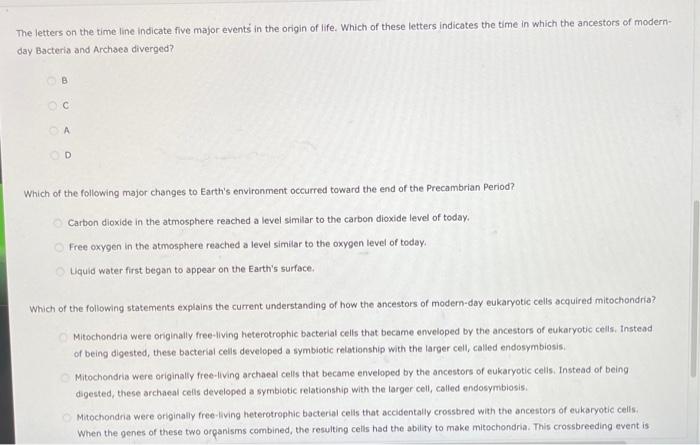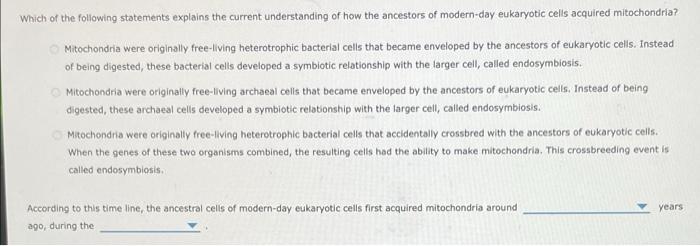Answered step by step
Verified Expert Solution
Question
1 Approved Answer
1. Evolution of life during the Precambrian Period Most of the major advancements in the development of life on Earth occurred during a time



1. Evolution of life during the Precambrian Period Most of the major advancements in the development of life on Earth occurred during a time early in Earth's history called the Precambrian Period. The following time line summarizes the current understanding of how the different forms of life developed during this period. The three main lineages are the three domains of life: Archaea, Eukarya, and Bacteria. The time line shows when different traits arose in these domains and how some traits passed from one domain to another. Use the slider bar at the bottom of the time line to move back and forth across the entire image. High hydrogen, low oxygen atmosphere Hadean Eon 4.5 4.0 Archean Eon 3.5 3.0 Oxygen released by bacteria begins to accumulate Precambrian Period Proterozoic Eon 2.5 2.0 Billions of Years Before the Present 1.5 1.0 Abmospheric oxygen maches modem level Phanerozoic Eon 0.5 Archaea Fungi, animals and some prot Plants, some protists Bacteria The letters on the time line indicate five major events in the origin of life. Which of these letters indicates the time in which the ancestors of modern- day Bacteria and Archaea diverged? OC A OD Which of the following major changes to Earth's environment occurred toward the end of the Precambrian Period? Carbon dioxide in the atmosphere reached a level similar to the carbon dioxide level of today. Free oxygen in the atmosphere reached a level similar to the oxygen level of today. Liquid water first began to appear on the Earth's surface. Which of the following statements explains the current understanding of how the ancestors of modern-day eukaryotic cells acquired mitochondria? Mitochondria were originally free-living heterotrophic bacterial cells that became enveloped by the ancestors of eukaryotic cells. Instead of being digested, these bacterial cells developed a symbiotic relationship with the larger cell, called endosymbiosis. Mitochondria were originally free-living archaeal cells that became enveloped by the ancestors of eukaryotic cells. Instead of being digested, these archaeal cells developed a symbiotic relationship with the larger cell, called endosymbiosis. Mitochondria were originally free-living heterotrophic bacterial cells that accidentally crossbred with the ancestors of eukaryotic cells. When the genes of these two organisms combined, the resulting cells had the ability to make mitochondria. This crossbreeding event is Which of the following statements explains the current understanding of how the ancestors of modern-day eukaryotic cells acquired mitochondria? Mitochondria were originally free-living heterotrophic bacterial cells that became enveloped by the ancestors of eukaryotic cells. Instead of being digested, these bacterial cells developed a symbiotic relationship with the larger cell, called endosymbiosis. Mitochondria were originally free-living archaeal cells that became enveloped by the ancestors of eukaryotic cells. Instead of being digested, these archaeal cells developed a symbiotic relationship with the larger cell, called endosymbiosis. Mitochondria were originally free-living heterotrophic bacterial cells that accidentally crossbred with the ancestors of eukaryotic cells. When the genes of these two organisms combined, the resulting cells had the ability to make mitochondria. This crossbreeding event is called endosymbiosis. According to this time line, the ancestral cells of modern-day eukaryotic cells first acquired mitochondria around ago, during the years
Step by Step Solution
★★★★★
3.45 Rating (171 Votes )
There are 3 Steps involved in it
Step: 1
1 The letter on the time line indicates 5 major events in the origin of life The letter C indicates ...
Get Instant Access to Expert-Tailored Solutions
See step-by-step solutions with expert insights and AI powered tools for academic success
Step: 2

Step: 3

Ace Your Homework with AI
Get the answers you need in no time with our AI-driven, step-by-step assistance
Get Started


